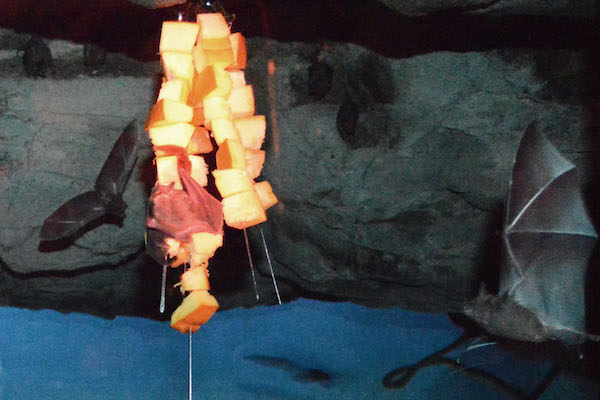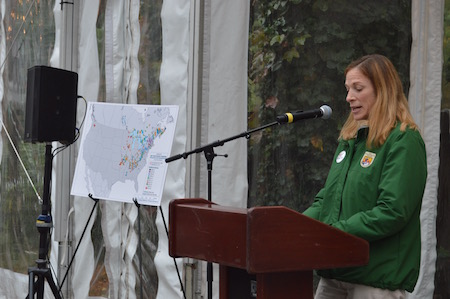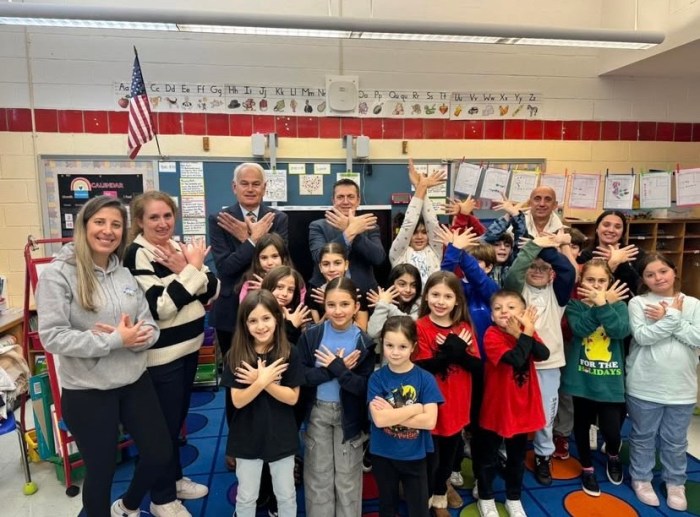
BY JACKSON CHEN | Wildlife conservationists gathered in Central Park on October 27 to announce a fund to combat the fungal epidemic that has “battered” the nation’s population of fuzzy flying mammals.
The US Fish and Wildlife Service (USFWS) and the National Fish and Wildlife Foundation (NFWF) teamed up to create the competitive grant program called the Bats for the Future Fund. The fund, already with a $1 million seed money investment from the USFWS, aims to research and develop treatments for white-nose syndrome. The disease has killed more than six million bats in the last 10 years and has wiped out 90 to 100 percent of bats in some specific sites. The US Forest Service has also committed to a minimum of $100,000 for the fund’s first year.
The October 27 event was the kickstarter for a fundraising drive soliciting support from private sources.
The name white-nose syndrome derives from the visible fungus that appears on bats’ muzzles and other parts of their body during their hibernation period. The fungus grows in the soil and walls of cold environments where bats can often be found hibernating during the winter. As bats hang motionless until the warmer months, the fungus continues to spread in the winter and eventually grows onto the bats.
“It starts to eat away at their skin and it wakes them up too many times,” Rob Mies, the executive director of the Organization for Bat Conservation, said of the fungus. “Once they wake up, then they go back into hibernation, they wake up again. They’re waking up seven times more often than healthy bats without the fungus.”
Besides making the furry fliers uncomfortable and itchy, the fungus causes the bats to raise their metabolic rate to fight off the invasion, but it’s at the cost of using the stored body fat that’s meant to help them last through winter, according to Mies.
Mies added that the fungus is an invasive species from Europe and was first discovered a decade ago near Albany. Since then, white-nose syndrome has spread to 29 states and five Canadian provinces, mostly through bat migration.

According to Wendi Weber, the northeast regional director for the USFWS, the fungus was detected in Washington State for the first time this year, and deemed it an “emergency room situation.”
“That’s a huge jump, a 1,300-mile jump, and what we weren’t anticipating was that it would jump that quickly and that far,” Weber said. “Because of this, bats are in real danger of extinction.”
If the number of bats keeps dwindling, Weber said the nation’s economy and environment would brunt the impact.
“Bats eat millions of insects in their life,” Weber said. “And so without bats, we believe you’d have to be applying a lot more insect control, pesticides, and chemicals to our really important agricultural crops.”
Besides serving as a natural insecticide, Mies said bats can also be considered the “farmers of the rainforest,” as they pollinate banana, guava, and agave, that last one which is used to make tequila.
So far, white-nose syndrome has been confirmed in seven species of cave-hibernating bats, with two of them being identified as endangered — the gray bat and the Indiana bat — and the northern long-eared bats that are classified as threatened, or likely to become endangered in the near future.
With the new Bats for the Future Fund, the agencies are hoping to give out grants to programs that prevent the spread of white-nose and research and projects that focus on treatment approaches.
Mies said that efforts so far have amounted to closing off many caves and mines since people and their gear can also spread the fungus. In terms of solving the problem, though, he said scientists have been testing various treatments in laboratories that treat either the bat’s habitat, its diet, or the bat itself.
According to the NFWF’s vice president of conservation programs, Eric Schwaab, they will be able to award the first round of grants in 2017 and continue doling out funding for government agencies, nonprofits, and scientists who are looking into treatment of white-nose syndrome. Schwaab noted that the grants would be especially important in the Midwest, which is what he considered the “leading edge of the disease’s march across the country.”




































